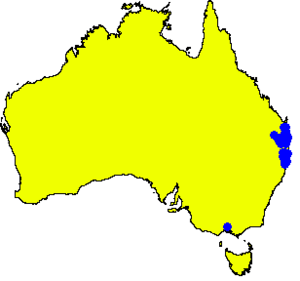Smudgee facts for kids
Quick facts for kids Smudgee |
|
|---|---|
| Scientific classification | |
| Genus: |
Angophora
|
| Species: |
woodsiana
|
 |
|
| Occurrence data from AVH | |
| Synonyms | |
|
|
The Angophora woodsiana, also known as smudgee, is a special kind of tree. It is a small to medium-sized tree that grows only in eastern Australia. This means it is endemic to that area.
You can spot a smudgee by its rough bark on its trunk and branches. It has long, narrow leaves, and its flowers are white or creamy white. After flowering, it grows ribbed, cup-shaped fruits.
Contents
What the Smudgee Tree Looks Like
The smudgee tree can grow quite tall, reaching up to 20 metres (about 65 feet). It has a special woody swelling at its base called a lignotuber. This helps the tree regrow if it gets damaged, like by a bushfire.
Bark and Leaves
The bark on the trunk and branches is rough and fibrous. It usually looks grey or brownish.
Young smudgee plants and new shoots (called coppice regrowth) have egg-shaped to lance-shaped leaves. These leaves are about 55 to 100 millimetres (2.2 to 3.9 inches) long and 20 to 30 millimetres (0.8 to 1.2 inches) wide. They grow in pairs directly opposite each other on the stem.
As the tree gets older, its adult leaves are also arranged in opposite pairs. They are shiny green on top but a lighter colour underneath. These leaves are lance-shaped or slightly curved. They measure about 75 to 170 millimetres (3.0 to 6.7 inches) long and 17 to 45 millimetres (0.7 to 1.8 inches) wide. Each leaf narrows down to a stalk called a petiole, which is about 10 to 20 millimetres (0.4 to 0.8 inches) long.
Flowers and Fruit
The smudgee's flowers grow at the ends of its branches. They are arranged on a main stalk called a peduncle, which is 9 to 32 millimetres (0.4 to 1.3 inches) long. Each part of this stalk holds groups of three or seven flower buds. These buds sit on smaller stalks called pedicels, which are 10 to 18 millimetres (0.4 to 0.7 inches) long.
When the buds are ready to open, they are shaped like a globe. They are about 6 to 7 millimetres (0.2 to 0.3 inches) long and wide. The base of the flower, called the floral cup, has ribs. The flower petals are white or creamy white and have a green line down the middle. They are about 3 to 4 millimetres (0.1 to 0.2 inches) long and wide.
Smudgee trees usually flower between December and January. After the flowers, the tree produces cup-shaped fruits. These fruits are like capsules, about 10 to 15 millimetres (0.4 to 0.6 inches) long and wide. The parts that open to release seeds (called valves) are hidden inside the fruit.
How the Smudgee Got Its Name
The Angophora woodsiana was first officially described in 1881. A scientist named Frederick Manson Bailey wrote about it in a science journal called Proceedings of the Linnean Society of New South Wales.
The second part of its scientific name, woodsiana, was chosen to honour a person. It was named after "the Rev. J. E. Tenison-Woods, F.G.S., who was the President of the Linnean Society of New South Wales."
Where Smudgee Trees Grow
Smudgee trees like to grow in sandy soil, especially on sandstone hills. You can find them in forests from Tin Can Bay in Queensland down to Coffs Harbour in New South Wales. They also pop up sometimes in the Darling Downs area.
Looking After the Smudgee Tree
Good news for the smudgee tree! In Queensland, the government has classified this tree as being of "least concern." This means that under the Queensland Government Nature Conservation Act 1992, it is not currently considered to be at risk of disappearing.

